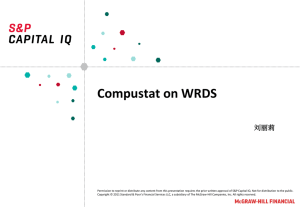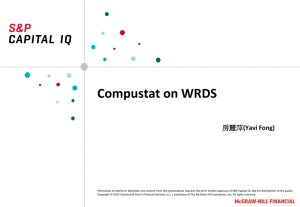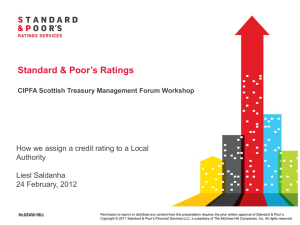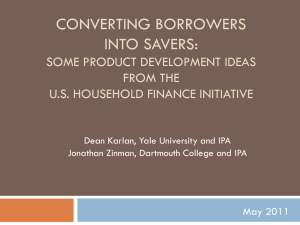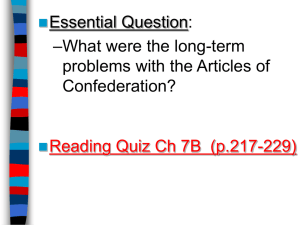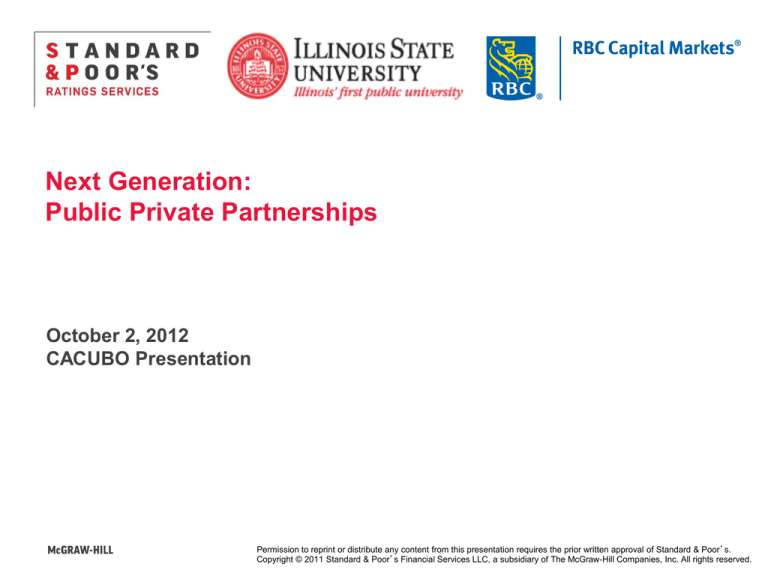
Next Generation:
Public Private Partnerships
October 2, 2012
CACUBO Presentation
Permission to reprint or distribute any content from this presentation requires the prior written approval of Standard & Poor’s.
Copyright © 2011 Standard & Poor’s Financial Services LLC, a subsidiary of The McGraw-Hill Companies, Inc. All rights reserved.
Presenters
• Illinois State University
– Dan Layzell, Vice President for Finance and Planning
• RBC Capital Markets
– Sara Russell, Vice President
• Standard and Poor’s
– Jessica Lukas, Associate Director, Higher Education Group
Permission to reprint or distribute any content from this presentation requires the prior written approval of Standard & Poor’s.
2.
Illinois State University
Dan Layzell
Vice President for Finance and Planning
Permission to reprint or distribute any content from this presentation requires the prior written approval of Standard & Poor’s.
3.
University Overview
• Illinois State University
– 1st public university in the State of Illinois, founded in 1857; one of 12 public
university campuses in state
– 960-acre main campus located in Normal, Illinois; midway between Chicago and
St. Louis
– Composed of six degree-granting colleges offering 68 undergraduate majors, 43
master’s programs, 9 doctoral program and 10 certificate programs
– Fall 2012 Enrollment overview
Total Headcount – 20,502
Undergraduate – 18,207
Graduate – 2,295
New Undergraduates (Freshmen and Transfers) – 4,964
– Primarily residential campus
Four-semester on-campus housing requirement
5,900 on-campus beds (down from a high of ~7,500 beds in the 1970s)
Permission to reprint or distribute any content from this presentation requires the prior written approval of Standard & Poor’s.
4.
University Overview
• Enrollment Trends – Total Headcount
– Annual on-campus enrollment target is 20,000 to 21,000
Permission to reprint or distribute any content from this presentation requires the prior written approval of Standard & Poor’s.
5.
University Overview
• Enrollment Trends
– Annual new undergraduate target is ~5,000, with 60/40 split between new
freshmen and transfers
Permission to reprint or distribute any content from this presentation requires the prior written approval of Standard & Poor’s.
6.
University Overview
Long Range Housing and Dining Plan
• Initiated in 2004
– Upgrade University housing and dining facilities
– Strategically right size campus housing and dining capacity to
accommodate future enrollment targets
– Planned decommissioning of selected facilities
– Rotated 400-800 beds offline each year
– Project completed in 2012
• Financing
– Total cost – $96M
– Equity financed with cash reserves - $48M
– Debt financed - $48M
Permission to reprint or distribute any content from this presentation requires the prior written approval of Standard & Poor’s.
7.
University Overview
• Occupancy rates & capacity
– On-campus beds were reduced from 6,600 in 2009-10 to 5,900 in Fall 2012
(including 900 in new Cardinal Court complex)
Note: Includes ~ 300 supplemental lounge spaces each year. Cardinal Court Fall 2012 occupancy – 99.3%.
Permission to reprint or distribute any content from this presentation requires the prior written approval of Standard & Poor’s.
8.
The On-Campus Housing Challenge and Decision Process
• On-Campus Housing Status
– Long-range Housing and Dining Plan completed in 2012
– Four-semester on-campus housing requirement
– State law requiring sprinklers in all residence halls effective January 2013
– Decision NOT to renovate South Campus Complex (~1,600 beds)
• Considerations
– Cost and other University debt-issuance needs
– No apartment-style housing on campus for undergraduates
– Land availability and options
– Time constraints
• Options
– Eliminate four-semester on-campus housing requirement
– Re-densify existing residence halls
– Build new residence hall
– Explore public-private partnership (P3) to address housing needs
Permission to reprint or distribute any content from this presentation requires the prior written approval of Standard & Poor’s.
9.
The On-Campus Housing Challenge and Decision Process
• Process
– Established cross-University working group to research possible P3 alternatives
– Developed RFP to invite proposals for housing project
– Variety of options proposed by private development teams
• Key Decision Criteria
– Project had to stand on its own financially – no University subsidies
– Had to be completed by Fall 2012
– University needed to retain management/quality control
– Reputation and track record of development team
• Timeline
– May 2010: Selection of ACC/CHF development team
– June 2010: BOT approval of project; executed ground lease with CHF
– July 2010 – February 2011
Market study
Project design/costing
Financing/legal issues and considerations
Permission to reprint or distribute any content from this presentation requires the prior written approval of Standard & Poor’s.
10.
The On-Campus Housing Challenge and Decision Process
• Timeline (cont.)
– March – June 2011: Demolition and site-work
– June 2011 – July 2012: Construction
– August 2012: Move-in
• Challenges and Observations
– Changes in State procurement/legal environment
– Political issues
– Unpredictability of financial markets
– First-time experience with P3; Some observations:
Take time to determine clear goals and priorities for the project
Be disciplined in evaluating and choosing the right P3 partner/team
Bring in experienced legal and financial advisors – it’s worth the added cost
Involve local government(s) in planning
Don’t underestimate the time required on the part of your institution during the
transaction to ensure a successful outcome
Don’t leave the details to others; be hands-on in working with P3 partners
Permission to reprint or distribute any content from this presentation requires the prior written approval of Standard & Poor’s.
11.
RBC Capital Markets
Sara Russell, Vice President
Permission to reprint or distribute any content from this presentation requires the prior written approval of Standard & Poor’s.
12.
Project Location
The Project is situated on the previous Cardinal Court Apartment site located on the main campus of the
University, an approximately 10 - 15 minute walk from the academic quad.
Project Site
Wright Hall
Haynie Hall
Wilkins Hall
Bone Student Center
Manchester Hall
Hewett Hall
Student Rec Center
Whitten Hall
Atkins Hall
Hamilton Hall
Quad
Colby Hall
Existing residence halls are labeled in blue.
Permission to reprint or distribute any content from this presentation requires the prior written approval of Standard & Poor’s.
13.
Watterson Towers
Project Description & Amenities
# of
Units
# of
Beds
Sq Ft
Per
Unit
2012-13
Monthly
Rent
2012-13
Semester
Rent
Unit A | 2 Bedroom / 2 Bath (Single Occupancy)
8
16
720
$806
$4,836
Unit B | 4 Bedroom / 4 Bath (Single Occupancy)
64
256
1,223
$641
$3,846
Unit C | 2 Bedroom / 2 Bath (Double Occupancy)
12
48
924
$575
$3,450
96
989
$605
$3,630
96
989
$575
$3,450
96
384
1,053
$605
$3,630
228
896
Unit Type
Unit D | 3 Bedroom / 2 Bath (Single Occupancy)
48
3 Bedroom / 2 Bath (Double Occupancy)
Unit E | 4 Bedroom / 2 Bath (Single Occupancy)
Total
• The project provides replacement housing and enables ISU to
“right-size” campus housing options.
• The community provides both private and semi-private bedroom and
bathroom accommodations for students.
• A 15,000 square foot community center provides for student
recreation, food service, residence life programming and outdoor
amenities.
• Resident amenities also include on-site parking, bicycle racks and a
campus shuttle bus stop.
Permission to reprint or distribute any content from this presentation requires the prior written approval of Standard & Poor’s.
14.
Transaction Overview
Developer
Conduit Issuer
Trust Indenture
Loan
Agreement
Ground Lease
Management Agreement
Dining/Café Sublease
Development
Agreement
Architect
Bond Trustee
Architect
Agreement
Borrower
CHF-Normal, L.L.C.
Bonds
Bond
Proceeds
Construction
Contract
Underwriter
Permission to reprint or distribute any content from this presentation requires the prior written approval of Standard & Poor’s.
15.
General Contractor
Structural Finance Considerations – Market Study
• August 2010 - CHF engaged CDS Market Research to conduct an independent
market feasibility study to evaluate the overall need for additional housing at ISU
–
Survey and analysis - evaluation of existing housing facilities both on and off campus, the
demand for additional housing, and the type of units and pricing that would best fulfill
students needs
• The market contains approximately 8,000 rental units in approximately 1,000 buildings
–
The complexes most immediately adjacent to campus are approximately 97% - 100%
occupied, though renters pay a premium price for the proximity to campus as compared to
some of the larger garden style units available further away.
• After project completion and the decommissioning of existing housing units, ISU’s total
housing stock will be approximately 6,000 beds (approximately 5,000 residence hall
beds and 1,000 apartment beds)
Permission to reprint or distribute any content from this presentation requires the prior written approval of Standard & Poor’s.
16.
Structural Finance Considerations – University Support
Ground Lease Support
Provisions
Management Agreement
Dining/Café Sublease
• Agreement to treat project as part
of ISU’s housing stock, on an equal
basis with other facilities
• Agreement coterminous with
the Ground Lease
• Covers a portion of the
community center used for
dining/café operations
• Students cannot be directed or
assigned to other facilities in
preference over the project
• Assumption of responsibility
for rent collection and
managing a series of restricted
accounting funds to administer
the Flow of Funds established
by the Trust Indenture
• Initial term of 10 years with
an option to terminate by ISU
after 5 years
• Agreement to decommission
certain buildings as further required
by Illinois Fire Sprinkler Dorm Act
• Assumption of responsibility
for project operations, payable
from project revenue
• Agreement to a market verification
covenant before any future housing
facilities are constructed
• Agreement to subordinate
reimbursement for overhead
and management fees
• Assumption of responsibility
for furnishing and operation of
the space and receives all
revenues from operations
• Agreement to maintain current
policies for student payment
delinquencies
• Fixed annual sublease
payments
Source: Official Statement | Illinois Finance Authority Student Housing Revenue Bonds (CHF-Normal, L.L.C. – Illinois State University Project)
Series 2011, February 10, 2011.
Permission to reprint or distribute any content from this presentation requires the prior written approval of Standard & Poor’s.
17.
Financing Summary
Par Amount
$59,610,000
Conduit Issuer
Illinois Finance Authority
Borrower
CHF-Normal, L.L.C., the sole member of which is Collegiate Housing Foundation, a 501(c)(3)
organization.
Structure / Ratings
Fully amortizing, tax-exempt student housing revenue bonds with a 32-year final maturity. Underlying
ratings of “Baa3” by Moody’s and “BBB-” by Standard & Poor’s are assigned.
Ground Lease
Long-term ground lease with a stated expiration on the 40th anniversary of the Commencement Date or
upon the full repayment of the financing, with an option for ISU to acquire the project at any time.
Payment Dates
Interest is paid semi-annually on each April and October 1st. Principal payments or sinking fund
redemptions will be made annually, on each April 1st, commencing April 1, 2013.
Optional Redemption
On or after April 1, 2021 at a redemption price of par, plus any accrued interest.
Construction Period
Approximately 18 months, with the project delivered on time and on budget in August 2012.
Security for the Bonds
The Bonds are secured solely by the revenues and assets of the project.
Reserve Funds
Bond proceeds funded capitalized interest through construction and stabilization and a debt service
reserve fund. Annual deposits to an R&R Fund will be made from project cash flows.
Management / University
Involvement
As Manager, the University will be responsible for the ongoing operation and maintenance of the
Project, including the collection of revenue and payment of operating expenses from such revenue. The
willwill
administer
Flow of net,
Funds
within
the Indenture
University
The University
enter intothe
an absolute
bond
type lease,
which willby
be creating
sufficient certain
to coverrestricted
debt
accounting
funds
into
which
Project
revenue
will
be
deposited
and
transferred
monthly
to the Trustee
service on the bonds and related expenses.
for debt service payments and to an Operating Account for operating expenses.
Source: Official Statement | Illinois Finance Authority Student Housing Revenue Bonds (CHF-Normal, L.L.C. – Illinois State University Project)
Series 2011, February 10, 2011.
Permission to reprint or distribute any content from this presentation requires the prior written approval of Standard & Poor’s.
18.
Financing Results
Sources of Funds
Par Amount of Bonds
Original Issue Discount
Original Issue Premium
Total
Uses of Funds
Construction Costs
Capitalized Interest Fund
Debt Service Reserve Fund
Estimated Issuance Costs
Total
Financing Statistics
Bond Arbitrage Yield **
All-In TIC **
Max Annual Debt Service
Total Net Debt Service
NPV of Surplus Cash Flow
Minimum DSCR
$
$
$
$
$
$
$
59,610,000.00
(838,165.60)
58,771,834.40
45,132,679.03
7,683,144.76
4,863,050.00
1,092,960.61
58,771,834.40
7.02%
7.19%
4,863,050.00
152,242,021.77
20,305,811.00
1.25
Operating Assumptions
Occupancy Rate
95%
Lease Term
12 months
Operating Expenses Per Bed
$1,628
Subordinated Expenses Per Bed
$637
Starting R&R Fund Deposit Per Bed
$175
Revenue/Expense Growth
3%
** Bond pricing on February 10, 2011 amid tumultous market
conditions. 30-year MMD rate equaled 4.94% at the time of
pricing and the muni market was seeing a dramatic widening
of credit spreads, wide spread selling and fund outflows.
Net Rental Revenue
Board Sublease Payments
Interest & Other Income
Total Revenue
2013 *
5,226,824
37,224
102,250
5,366,298
2014
6,460,354
37,224
202,579
6,700,157
2015
6,654,165
37,224
205,738
6,897,127
2016
6,853,790
37,224
208,992
7,100,006
2017
7,059,404
37,224
212,344
7,308,972
Salaries, Wages & Benefits
Repairs & Maintenance
Utilities
Marketing & Leasing
Insurance
General & Administrative
Project Finance / Reporting Fees
Total Operating Expenses
336,089
330,500
609,120
19,000
30,000
71,361
62,500
1,458,570
346,172
340,415
627,394
19,570
30,900
73,502
62,500
1,500,452
356,557
350,627
646,215
20,157
31,827
75,707
62,500
1,543,591
367,254
361,146
665,602
20,762
32,782
77,978
62,500
1,588,023
378,271
371,981
685,570
21,385
33,765
80,317
62,500
1,633,789
Net Operating Income
3,907,728
5,199,705
5,353,536
5,511,983
5,675,183
Annual Debt Service **
Debt Service Coverage
Breakeven Occupancy
678,046
5.76
36.98%
4,158,275
1.25
80.23%
4,283,325
1.25
80.25%
4,406,225
1.25
80.19%
4,531,700
1.25
80.11%
Subordinated Expenses
Repair & Replacement Fund
Borrower Fee
Management Fee
University Overhead
156,800
79,936
266,454
224,000
161,504
98,485
328,284
230,720
166,349
101,440
338,132
237,642
171,340
104,483
348,276
244,771
176,480
107,617
358,724
252,114
Surplus Cash Flow
2,502,492
222,437
226,649
236,889
248,548
* First year revenue based on an initial 10-month period based on project delivery and planned lease cycle.
* Debt Service is shown net of capitalized interest.
Source: RBC Capital Markets and Official Statement | Illinois Finance Authority Student Housing Revenue Bonds (CHF-Normal, L.L.C. – Illinois
State University Project) Series 2011, February 10, 2011.
Permission to reprint or distribute any content from this presentation requires the prior written approval of Standard & Poor’s.
19.
Fixed Rate Municipal Market Update
Municipal Yields
Municipal yields are near all time historical levels
Current
1 Month Ago 1 Year Ago ISU Pricing
09/27/2012 08/27/2012 09/27/2011 02/10/2011
0.20%
0.20%
0.23%
0.37%
0.36%
0.37%
0.47%
1.14%
0.62%
0.70%
0.97%
1.92%
1.71%
1.76%
2.09%
3.38%
2.88%
2.90%
3.52%
4.94%
Maturity
1-Year
3-Year
5-Year
10-Year
30-Year
AAA Historical Municipal Yields
“AAA” MMD is the composite yield curve comprised of “AAA” rated
general obligation municipal issues by which other municipal issues
are benchmarked.
30-Year US Tsy
30-Year Muni-to-Tsy
2.84%
101.41%
2.76%
105.07%
Source: TM3 | AAA MMD GO Index
6.00%
5.50%
5.00%
4.50%
4.00%
3.50%
3.00%
2.50%
2.00%
1.50%
01/02/01
01/02/02
01/02/03
01/02/04
01/02/05
01/02/06
01/02/07
30 Year AAA
01/02/08
01/02/09
01/02/10
01/02/11
10 Year AAA
Source: RBC Capital Markets
Permission to reprint or distribute any content from this presentation requires the prior written approval of Standard & Poor’s.
20.
01/02/12
3.07%
114.66%
4.77%
103.56%
A Rating Agency Perspective
Jessica Lukas, Associate Director
Standard and Poor’s
Permission to reprint or distribute any content from this presentation requires the prior written approval of Standard & Poor’s.
21.
Current Debt Trends
Public University
Median Debt per FTE By Rating Category 2011-2007
2011
2010
2009
2008
•
2007
50,000
45,000
40,000
35,000
General Characteristics
• Debt Issuance Increasing
• Deferred maint. growing
• Issuers remain conservative
30,000
25,000
20,000
Private University
15,000
10,000
5,000
Median Debt per FTE By Rating Category 2011-2007
0
AAA
AA
A
BBB
2011
2010
2009
2008
2007
180,000
•
Types of Debt and Structure
• No major trend changes in
security types
• Direct purchase bonds
• Century bonds
• Off-balance sheet bonds*
160,000
140,000
120,000
100,000
80,000
60,000
40,000
20,000
AAA
Permission to reprint or distribute any content from this presentation requires the prior written approval of Standard & Poor’s.
22.
AA
A
BBB
Traditional vs. Private Housing
• Difference between traditional housing and private housing
– Connectivity: university management, ownership or oversight
– Location: on-campus/ off-campus
• Credit Risk Relationship Model
– University’s long term viability and credit rating
– Economic interest and control
– Demand for housing
– Linkage to university
– Stand alone or housing system
Permission to reprint or distribute any content from this presentation requires the prior written approval of Standard & Poor’s.
23.
S&P Criteria
• Criteria that Standard and Poor’s follows:
– Location
– Management
– Rate covenants and bond test
Cash flows
– Reserves and insurance
– Occupancy rates and breakeven levels
– Construction risk
– Debt structure
– Long term rating of institution
WICHE = Western Interstate Commission for Higher Education.
Permission to reprint or distribute any content from this presentation requires the prior written approval of Standard & Poor’s.
24.
Current Debt Trends
Off Balance sheet debt
• Characteristics
– Avg actual cov. across all ratings 1.9x
– Avg beds +2000 (1460 BBB+ and below)
– Avg cov require 1.2x
– System pledge 2/3’s of deals
Permission to reprint or distribute any content from this presentation requires the prior written approval of Standard & Poor’s.
25.
CHF-Normal, LLC – Rating Strengths
Overview of OBS Rating (from Standard and Poor’s Perspective)
• ISU's (A+/ Stable) solid demand for university-owned housing, which operates at over
96% of capacity
• New project beds are substantially replacement stock
• The bonds' adequate security features
• High connectivity between ISU and the project, as demonstrated by the project's oncampus location, ISU's management, oversight, and active role in marketing the new
housing as part of its own housing stock, and eventual ownership of the project once
the bonds are repaid
• The project's assumed break-even (1.0x) occupancy levels of 83.6%, which we
consider manageable
• ISU's stable enrollment and demand trends - with fall 2011's enrollment of 21,080,
71% freshman selectivity, and 36% matriculation rate.
Permission to reprint or distribute any content from this presentation requires the prior written approval of Standard & Poor’s.
26.
Connectivity – University support for the project
• The new housing facility represents a small portion of total on-campus beds
(approximately 15%) at ISU
• Replacement Housing - as the new housing becomes available, the university plans
to take approximately 1,774 beds offline
• Ground lease - contains provisions outlining the university's support for the project,
which includes the decommissioning of the aforementioned existing housing facilities
• The new apartment complex will be located on campus; a natural pathway will
connect the facilities with the main campus.
Permission to reprint or distribute any content from this presentation requires the prior written approval of Standard & Poor’s.
27.
Management & Flow of Funds
Why is this important?
• Who will manage the housing units?
• Who will market the housing units?
• Will the housing units be connected to the campus computer system?
• Will they have the benefits of university campus parking and police services?
• What type of housing contract will be used? And, will it enforce the same terms and
conditions as other university housing?
• Who will collect monthly all housing rental payments and who will transmit revenues to
the trustee to provide for the funding of debt service payments and other financing
related expenses?
• What will happen to any surplus funds, after debt service coverage has been met?
Permission to reprint or distribute any content from this presentation requires the prior written approval of Standard & Poor’s.
28.
CHF Transaction – Flow of Funds
Student Rental Payments
collected by the University under the Management
Agreement and held by the University in restricted accounts
Revenue Fund
On the last business day of each month,
the University shall make transfers for:
On the 20th day of each month, the University
shall make the following disbursement to the
Trustee for the Bond Fund:
amounts remaining after monthly transfers
Bond Fund
Reimbursement of Overhead
amount equal to 1/6th of interest and 1/12th of
principal for the next succeeding payment due
On the 20th day of each month, the University
shall make the following disbursements:
3
Issuer & Trustee Fees
amount then due and payable
Operational Expense Fund
amount shown in the Annual Budget for
Op Ex for the next succeeding month
Debt Service Reserve Fund
amount of any replenishments necessary
Repair & Replacement Fund
$175/bed/year escalating annually at 3%
Payment of Borrower Fees
if funds are available
Payment of Management Fees
if funds are available
Operations Contingency Fund
all amounts remaining
Replenishment of Funds
Bond Fund, Operational Expense Fund,
Debt Service Reserve Fund, R&R Fund
On June 30th of each year, the University shall
deposit monies remaining in the Operations
Contingency Fund into:
Surplus Fund
Amounts remaining in the Surplus Fund at the end of
the Fiscal Year are retained by the University as
Ground Rent provided that the Release Test is met.
Source: Official Statement | Illinois Finance Authority Student Housing Revenue Bonds (CHF-Normal, L.L.C. – Illinois State University Project)
Series 2011, February 10, 2011.
Permission to reprint or distribute any content from this presentation requires the prior written approval of Standard & Poor’s.
29.
CHF-Normal, LLC – Offsetting Characteristics
Rating Limitations:
• Nonrecourse security pledge of project net revenues
• New construction risk
• Financial projections that indicate a 1.0x (not including debt service reserves) inground maximum annual debt service (MADS) coverage with expected MADS of $4.9
million on projected fiscal 2014 net operating income (first full year without any
capitalized interest) of $4.9 million
• A management agreement that includes equal treatment of the housing project within
ISU's student housing program; however, there is no priority assignment or "first fill"
requirement
Permission to reprint or distribute any content from this presentation requires the prior written approval of Standard & Poor’s.
30.
Finance Structure = Investment Grade Credit
• Approximately $60 million fixed rate bond issuance
• Nonrecourse security, self retirement of debt through project cash flows
• New construction risk
• Capitalized interest & replacement reserve funds
• Adequate debt service coverage
• University supported contracted services agreement
• Solid enrollment and expected student demand
S&P rating of BBB- / Stable
Permission to reprint or distribute any content from this presentation requires the prior written approval of Standard & Poor’s.
31.
Cardinal Court
Before….
After….
• Project construction commenced in March 2011 and was completed by August 2012
• Construction was on time and on budget
• Student demand for the property is strong, with fall 2012 occupancy of 99%
Permission to reprint or distribute any content from this presentation requires the prior written approval of Standard & Poor’s.
32.
Question & Answer Session
Permission to reprint or distribute any content from this presentation requires the prior written approval of Standard & Poor’s.
33.
Contact Information
Jessica Lukas
(312) 233-7004
Jessica_lukas@standardandpoors.com
Dan Layzell
(309) 438-2775
Dlayzel@ilstu.edu
Sara Russell
(410) 625-6119
Sara.russell@rbccm.com
Permission to reprint or distribute any content from this presentation requires the prior written approval of Standard & Poor’s.
34.
www.standardandpoors.com
Copyright © 2011 by Standard & Poor’s Financial Services LLC. All rights reserved.
No content (including ratings, credit-related analyses and data, model, software or other application or output therefrom) or any part thereof (Content) may be modified, reverse engineered, reproduced or
distributed in any form by any means, or stored in a database or retrieval system, without the prior written permission of Standard & Poor’s Financial Services LLC or its affiliates (collectively, S&P). The
Content shall not be used for any unlawful or unauthorized purposes. S&P and any third-party providers, as well as their directors, officers, shareholders, employees or agents (collectively S&P Parties) do not
guarantee the accuracy, completeness, timeliness or availability of the Content. S&P Parties are not responsible for any errors or omissions (negligent or otherwise), regardless of the cause, for the results
obtained from the use of the Content, or for the security or maintenance of any data input by the user. The Content is provided on an “as is” basis. S&P PARTIES DISCLAIM ANY AND ALL EXPRESS OR
IMPLIED WARRANTIES, INCLUDING, BUT NOT LIMITED TO, ANY WARRANTIES OF MERCHANTABILITY OR FITNESS FOR A PARTICULAR PURPOSE OR USE, FREEDOM FROM BUGS,
SOFTWARE ERRORS OR DEFECTS, THAT THE CONTENT’S FUNCTIONING WILL BE UNINTERRUPTED OR THAT THE CONTENT WILL OPERATE WITH ANY SOFTWARE OR HARDWARE
CONFIGURATION. In no event shall S&P Parties be liable to any party for any direct, indirect, incidental, exemplary, compensatory, punitive, special or consequential damages, costs, expenses, legal fees,
or losses (including, without limitation, lost income or lost profits and opportunity costs or losses caused by negligence) in connection with any use of the Content even if advised of the possibility of such
damages.
Credit-related and other analyses, including ratings, and statements in the Content are statements of opinion as of the date they are expressed and not statements of fact. S&P’s opinions, analyses and rating
acknowledgment decisions (described below) are not recommendations to purchase, hold, or sell any securities or to make any investment decisions, and do not address the suitability of any security.. S&P
assumes no obligation to update the Content following publication in any form or format. The Content should not be relied on and is not a substitute for the skill, judgment and experience of the user, its
management, employees, advisors and/or clients when making investment and other business decisions.. S&P does not act as a fiduciary or an investment advisor except where registered as such. While
S&P has obtained information from sources it believes to be reliable, S&P does not perform an audit and undertakes no duty of due diligence or independent verification of any information it receives.
To the extent that regulatory authorities allow a rating agency to acknowledge in one jurisdiction a rating issued in another jurisdiction for certain regulatory purposes, S&P reserves the right to assign,
withdraw or suspend such acknowledgement at any time and in its sole discretion. S&P Parties disclaim any duty whatsoever arising out of the assignment, withdrawal or suspension of an acknowledgment as
well as any liability for any damage alleged to have been suffered on account thereof.
S&P keeps certain activities of its business units separate from each other in order to preserve the independence and objectivity of their respective activities. As a result, certain business units of S&P may
have information that is not available to other S&P business units. S&P has established policies and procedures to maintain the confidentiality of certain non-public information received in connection with each
analytical process.
S&P may receive compensation for its ratings and certain analyses, normally from issuers or underwriters of securities or from obligors. S&P reserves the right to disseminate its opinions and analyses. S&P's
public ratings and analyses are made available on its Web sites, www.standardandpoors.com (free of charge), and www.ratingsdirect.com and www.globalcreditportal.com (subscription), and may be
distributed through other means, including via S&P publications and third-party redistributors. Additional information about our ratings fees is available at www.standardandpoors.com/usratingsfees.
Permission to reprint or distribute any content from this presentation requires the prior written approval of Standard & Poor’s.
35.
STANDARD & POOR’S, S&P, GLOBAL CREDIT PORTAL and RATINGSDIRECT are registered trademarks of Standard & Poor’s Financial Services LLC.
Disclaimer
RBC Capital Markets, LLC (“RBC CM”) is providing the information contained in this document for discussion purposes only and not in
connection with RBC CM serving as Underwriter, Investment Banker, municipal advisor, financial advisor or fiduciary to a financial transaction
participant or any other person or entity. RBC CM will not have any duties or liability to any person or entity in connection with the information
being provided herein. The information provided is not intended to be and should not be construed as “advice” within the meaning of Section
15B of the Securities Exchange Act of 1934. The financial transaction participants should consult with its own legal, accounting, tax, financial
and other advisors, as applicable, to the extent it deems appropriate.
This presentation was prepared exclusively for the benefit of and internal use by the recipient for the purpose of considering the transaction or
transactions contemplated herein. This presentation is confidential and proprietary to RBC Capital Markets, LLC (“RBC CM”) and may not be
disclosed, reproduced, distributed or used for any other purpose by the recipient without RBCCM’s express written consent.
By acceptance of these materials, and notwithstanding any other express or implied agreement, arrangement, or understanding to the contrary,
RBC CM, its affiliates and the recipient agree that the recipient (and its employees, representatives, and other agents) may disclose to any and
all persons, without limitation of any kind from the commencement of discussions, the tax treatment, structure or strategy of the transaction
and any fact that may be relevant to understanding such treatment, structure or strategy, and all materials of any kind (including opinions or
other tax analyses) that are provided to the recipient relating to such tax treatment, structure, or strategy.
The information and any analyses contained in this presentation are taken from, or based upon, information obtained from the recipient or from
publicly available sources, the completeness and accuracy of which has not been independently verified, and cannot be assured by RBC CM.
The information and any analyses in these materials reflect prevailing conditions and RBC CM’s views as of this date, all of which are subject
to change.
To the extent projections and financial analyses are set forth herein, they may be based on estimated financial performance prepared by or in
consultation with the recipient and are intended only to suggest reasonable ranges of results. The printed presentation is incomplete without
reference to the oral presentation or other written materials that supplement it.
IRS Circular 230 Disclosure: RBC CM and its affiliates do not provide tax advice and nothing contained herein should be construed as tax
advice. Any discussion of U.S. tax matters contained herein (including any attachments) (i) was not intended or written to be used, and cannot
be used, by you for the purpose of avoiding tax penalties; and (ii) was written in connection with the promotion or marketing of the matters
addressed herein. Accordingly, you should seek advice based upon your particular circumstances from an independent tax advisor.
Permission to reprint or distribute any content from this presentation requires the prior written approval of Standard & Poor’s.
36.


